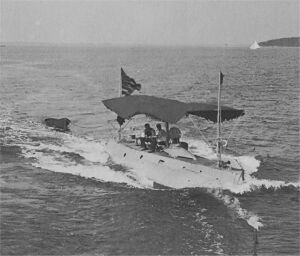Holland Torpedo Boat Company Station
The Holland Torpedo Boat Company Station

The move of the HTBC subsidiary to New Suffolk without Holland's knowledge was actually one of a series of Machiavellian business moves by Rice, who sought total control of the company and was seeking to move Holland out of the way, literally and figuratively. Holland had already signed over his patents to Electric Boat in a move to raise capital for continued tests and future construction. However, there was also a very practical reason for the move as well. The previous testing areas for the Holland boat had been in Raritan Bay off Staten Island, NY and Perth Amboy, NJ near the Crescent building yard. Inevitably, the trials of the submarine garnered tremendous interest from the press and the New York City public alike and the submarine was often accompanied by a plethora of pleasure craft, making it potentially dangerous to operate the boat submerged. The move to rural New Suffolk gave the company a reasonably private operating area to test the boat in, and it kept it from the bulk of the prying eyes of the press.
The trials of the Holland VI on Great Peconic Bay were entirely successful and after a haulout for minor modifications and repairs at Greenport, NY and one more trial run the boat was finally purchased by the Navy in April, 1900 and commissioned as the Holland in October. Electric Boat, however, was already looking to the future. Entirely at their own expense they contracted with Crescent Shipyard to build a larger and improved version of the Holland, with the intent of using her as a demonstration model for seven copies that Rice was working diligently to get the Navy to purchase. This new boat, called Fulton, was quickly moved to New Suffolk for testing and demonstration trials. The Fulton trials were entirely successful and they cleared the bureaucratic logjam around the authorization for the seven Adder-class submarines, five of which quickly followed the Fulton to New Suffolk (two of them were built in San Francisco).
Fulton, Adder, Plunger, Moccasin, Porpoise, and Shark were joined in New Suffolk by a company owned tugboat called the Kelpie, which accompanied the boats as they made their initial trial runs in Great Peconic Bay. In addition, the hulk of a never completed steam powered submarine contracted to Holland's company in 1895 (also called the Plunger) was towed up to the station and moored to the quay wall inside the basin. New Suffolk became a busy place for several years, with the new Adder-class submarines arriving regularly and trials being run out in the bay. New Suffolk was far enough away from New York City to keep the public and press at bay, but Rice was savvy enough to understand the advantages of getting favorable publicity and thus selected members of the press were often invited out to view the comings and goings around the station. The nearby southern shore of Long Island was also becoming a popular destination for summer vacations of the New York elite, and thus viewing the submarine movements became a favored pastime for Rice's colleagues.
Page created by:
Ric Hedman & David Johnston
1999 - 2023 - PigBoats.COM©
Mountlake Terrace, WA, Norfolk, VA
webmaster@pigboats.com
